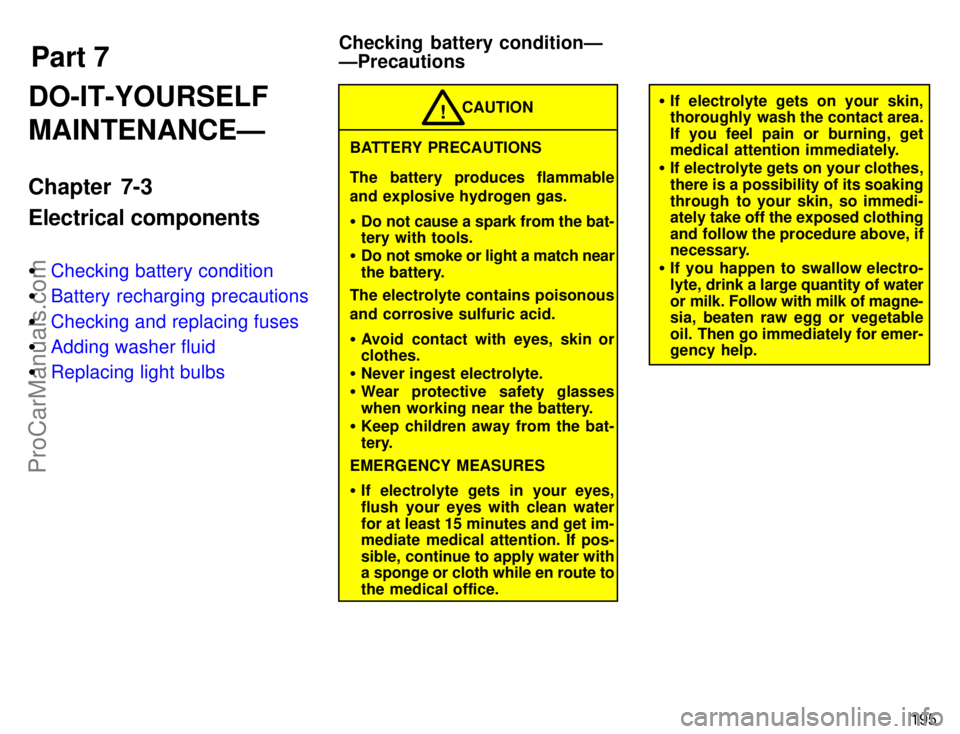Page 190 of 226

184Checking power steering fluid
Parts (if level is low):
�Automatic transmission fluid DEX-
RON
[-II or -III
Tools:
�Rag or paper towel
�Funnel (only for adding fluid)
Checking battery condition
Non-maintenance batteriesÐ
Tools:
�Warm water
�Baking soda
�Grease
�Conventional wrench (for terminal
clamp bolts)
Maintenance type batteriesÐ
Parts (if level is low):
�Distilled water
Tools:
�Warm water
�Baking soda
�Grease
�Conventional wrench (for terminal
clamp bolts)
�Coin (for vent plugs)
�Funnel (only for adding distilled water)Checking and replacing fuses
Parts (if replacement is necessary):
�Genuine Toyota fuse or equivalent
with same amperage rating as original
Tools:
�Screwdriver (for passenger's side kick
panel and instrument panel screw)
�Conventional wrench (for passenger's
side kick panel nut)
Adding washer fluid
Parts:
�Water
�Washer fluid containing antifreeze (for
winter use)
Tools:
�Funnel
Replacing light bulbs
Parts:
�Bulb with same number and wattage
rating as original (See charts in Re-
placing light bulbsº in Chapter 7-3.)
Tools:
�Screwdriver
�Conventional wrench
ProCarManuals.com
Page 201 of 226

Part 7
Checking battery conditionÐ
ÐPrecautions
195
DO-IT-YOURSELF
MAINTENANCEÐ
Chapter 7-3
Electrical components
�Checking battery condition
�Battery recharging precautions
�Checking and replacing fuses
�Adding washer fluid
�Replacing light bulbs
BATTERY PRECAUTIONS
The battery produces flammable
and explosive hydrogen gas.
�Do not cause a spark from the bat-
tery with tools.
�Do not smoke or light a match near
the battery.
The electrolyte contains poisonous
and corrosive sulfuric acid.
�Avoid contact with eyes, skin or
clothes.
�Never ingest electrolyte.
�Wear protective safety glasses
when working near the battery.
�Keep children away from the bat-
tery.
EMERGENCY MEASURES
�If electrolyte gets in your eyes,
flush your eyes with clean water
for at least 15 minutes and get im-
mediate medical attention. If pos-
sible, continue to apply water with
a sponge or cloth while en route to
the medical office.CAUTION
!�If electrolyte gets on your skin,
thoroughly wash the contact area.
If you feel pain or burning, get
medical attention immediately.
�If electrolyte gets on your clothes,
there is a possibility of its soaking
through to your skin, so immedi-
ately take off the exposed clothing
and follow the procedure above, if
necessary.
�If you happen to swallow electro-
lyte, drink a large quantity of water
or milk. Follow with milk of magne-
sia, beaten raw egg or vegetable
oil. Then go immediately for emer-
gency help.
ProCarManuals.com
Page 205 of 226

199
If the headlights or other electrical
components do not work, check the
fuses. If any of the fuses are blown,
they must be replaced.
See Fuse locationsº in Chapter 7-1 for
locations of the fuses.
Turn the ignition switch and inopera-
tive component off. Pull a suspected
fuse straight out and check it.
Determine which fuse may be causing the
problem. The lid of the fuse box shows the
name of the circuit for each fuse. See Part
8 of this manual for the functions con-
trolled by each circuit.
Type A and B fuses can be pulled out by
using the pull-out tool.If you are not sure whether the fuse has
blown, try replacing the suspected fuse
with one that you know is good.
If the fuse has blown, push a new fuse
into the clip.
Only install a fuse with the amperage rat-
ing designated on the fuse box lid.
If you do not have a spare fuse, in an
emergency you can pull out the CIG/RA-
DIOº, DOMEº or A/Cº fuse, which may
be dispensable for normal driving, and
use it if its amperage rating is the same.
If you cannot use one of the same amper-
age, use one that is lower, but as close as
possible to the rating. If the amperage is
lower than that specified, the fuse might
blow out again but this does not indicate
anything wrong. Be sure to get the correct
fuse as soon as possible and return the
substitute to its original clip.
It is a good idea to purchase a set of spare
fuses and keep them in your vehicle for
emergencies.
If the new fuse immediately blows out,
there is a problem with the electrical sys-
tem. Have your Toyota dealer correct it as
soon as possible.
Checking and replacing fuses
ProCarManuals.com
Page 215 of 226
Sedan Coupe Wagon
Overall length mm (in.) 4770 (187.8) 4770 (187.8) 4810 (189.4)
Overall width mm (in.) 1770 (69.7) 1770 (69.7) 1770 (69.7)
Overall height mm (in.) 1400 (55.1)*
11395 (54.9)*11430 (56.3)*3
1415 (55.7)*21410 (55.5)*21450 (57.1)*4
1435 (56.5)*5
1455 (57.3)*6
Wheelbase mm (in.) 2620 (103.1) 2620 (103.1) 2620 (103.1)
Front tread mm (in.) 1550 (61.0) 1550 (61.0) 1550 (61.0)
Rear tread mm (in.) 1500 (59.1) 1500 (59.1) 1500 (59.1)
Vehicle capacity weight kg (lb.) 410 (900) 410 (900) 495 (1095)*
7
(occupants + luggage) 430 (945)*8
*1: Unladen vehicle plus two occupants
*
2: Unladen vehicle
*
3: Unladen vehicle plus two occupants with 5S-FE engine
*
4: Unladen vehicle with 5S-FE engine
*
5: Unladen vehicle plus two occupants with 1MZ-FE engine
*
6: Unladen vehicle with 1MZ-FE engine
*
7: With third seat
*
8: Without third seat
Part 8Dimensions and weight
209
SPECIFICATIONS
�Dimensions and weight
�Engine
�Fuel
�Service specifications
�Tires
�Fuses
ProCarManuals.com
Page 222 of 226

216
Fuses (type A)
1. HORN 10 A: Horn
2. HEAD (LH) 15 A: Left-hand headlight
3. ALT-S 7.5 A: Charging system
4. HEAD (RH) 15 A: Right-hand head-
light
5. DOME 20 A: Audio system, interior
light, clock, ignition switch light, personal
light, trunk light, luggage compartment
light, vanity mirror light, electric moon roof
6. EFI 15 A: Multiport fuel injection sys-
tem/sequential multiport fuel injection
system
7. AM2 30 A: Multiport fuel injection sys-
tem/sequential multiport fuel injection
system, starting system8. ECU-B 15 A: Anti-lock brake system,
daytime running light system, cruise con-
trol system
9. HAZ 10 A: Emergency flasher
10. HEAD HI (LH) 15 A: Left-hand head-
light (high beam)
11.HEAD HI (RH) 15 A: Right-hand
headlight (high beam)
12. OBD 7.5 A: On-board diagnosis sys-
tem
13. SPARE 7.5 A: Spare fuse
14. SPARE 15 A: Spare fuse
15. SPARE 30 A: Spare fuse
16. TEL 15 A: No circuitFuses (type B)
17. ECU-IG 15 A: Electronically con-
trolled automatic transmission system,
cruise control system, anti-lock brake
system
18. GAUGE 10 A: Gauges and meters,
back-up lights, air conditioning control
system, rear window defogger, service re-
minder indicators, daytime running light
system, tilt steering
19. STOP 15 A: Stop lights, cruise con-
trol system, anti-lock brake system, shift
lock system
20. SEAT HTR 15 A: No circuit
Fuses
ProCarManuals.com
Page 223 of 226

217
21. WIPER 20 A: Windshield wipers and
washer, rear window wipers and washer,
air bag system
22. TURN 7.5 A: Turn signal lights
23. IGN 7.5 A: Multiport fuel injection sys-
tem/sequential multiport fuel injection
system, charging system, air bag system
24. CIG/RADIO 15 A: Audio system,
daytime running light system, clock, ciga-
rette lighter, air bag system, shift lock sys-
tem
25. MIR. HTR 10 A: Outside rear view
mirror heater26. TAIL 15 A: Tail lights, parking lights,
license plate lights, instrument panel
lights, rear light failure warning system
27. SRS 7.5 A: SRS airbag system
28. A/C 10 A: Air conditioning control
system
29. HEAD (LWR-RH) 15 A: Right-hand
headlight (low beam)
30. HEAD (LWR-LH) 15 A: Left-hand
headlight (low beam)
31. DRL 5 A: Daytime running light sys-
tem
32. ST 10 A: Starting systemFuses (type C)
33. AM1 40 A: Starting system
34. P/W 30 A: Electric moon roof, power
windows, tilt steering, power door lock
controls, power back door lock control,
power seat
35. DEFOG 40 A: Rear window defogger
36. HTR 40 A: Air conditioning control
system
37. MAIN NO. 1 40 A: Starting system
38. CDS 30 A: Electric cooling fan
39. RDI 30 A: Electric cooling fan
ProCarManuals.com
Page 224 of 226
218
Fuses (type D)
40. ALT 100 A: Charging system
41. ALT 120 A: Charging system
42. A.B.S. 60 A: Anti-lock brake system
ProCarManuals.com